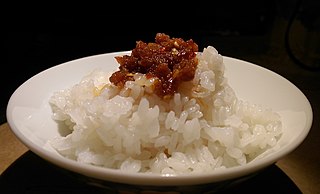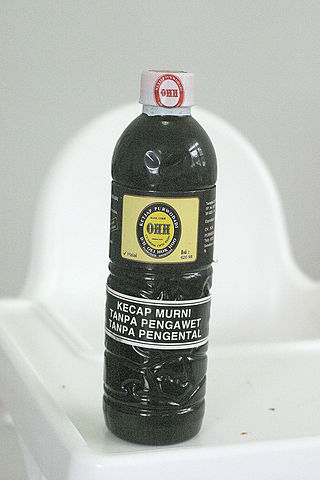
Fish sauce is a liquid condiment made from fish or krill that have been coated in salt and fermented for up to two years. It is used as a staple seasoning in East Asian cuisine and Southeast Asian cuisine, particularly Myanmar, Cambodia, Laos, Philippines, Thailand, and Vietnam. Some garum-related fish sauces have been used in the West since the Roman times.

In cooking, a sauce is a liquid, cream, or semi-solid food, served on or used in preparing other foods. Most sauces are not normally consumed by themselves; they add flavor, moisture, and visual appeal to a dish. Sauce is a French word taken from the Latin salsa, meaning salted. Possibly the oldest recorded European sauce is garum, the fish sauce used by the Ancient Romans, while doubanjiang, the Chinese soy bean paste is mentioned in Rites of Zhou in the 3rd century BC.

Gravy is a sauce often made from the juices of meats that run naturally during cooking and often thickened with wheat flour or corn starch for added texture. The gravy may be further coloured and flavoured with gravy salt or gravy browning or ready-made cubes and powders can be used as a substitute for natural meat or vegetable extracts. Canned and instant gravies are also available. Gravy is commonly served with roasts, meatloaf, rice, noodles, chips (fries), mashed potatoes, or biscuits.

Pico de gallo, also called salsa fresca, salsa bandera, and salsa cruda, is a type of salsa commonly used in Mexican cuisine. It is traditionally made from chopped tomato, onion, and serrano peppers, with salt, lime juice, and cilantro.

Teriyaki is a cooking technique in which foods are broiled or grilled with a glaze of soy sauce, mirin, and sugar. Although commonly associated with Japanese cuisine, this cooking technique is also commonly used in other Asian cuisines such as Chinese cuisine, Indonesian cuisine and Thai cuisine.

Mirin is a type of rice wine and a common ingredient in Japanese cooking. It is similar to sake but with a lower alcohol content and higher sugar content. The sugar content is a complex carbohydrate that forms naturally during the fermentation process; no sugars are added. The alcohol content is further lowered when the liquid is heated.

Belgian cuisine is widely varied with significant regional variations, while also reflecting the cuisines of neighbouring France, Germany and the Netherlands. It is sometimes said that Belgian food is served in the quantity of German cuisine but with the quality of French food. Outside the country, Belgium is best known for its chocolate, waffles, fries and beer.

Fry sauce is a condiment often served with French fries or tostones in many places in the world. It is usually a combination of one part tomato ketchup and two parts mayonnaise. Historically, the Argentinian salsa golf is most likely the first ketchup and mayonnaise sauce, having been invented in the 1920s by Luis Leloir.

Salsa encompasses a variety of sauces used as condiments for tacos and other Mexican and Mexican-American foods, and as dips for tortilla chips. They may be raw or cooked, and are generally served at room temperature.

Shawarma is a Middle Eastern dish that originated in the Ottoman Empire, consisting of meat cut into thin slices, stacked in an inverted cone, and roasted on a slowly turning vertical rotisserie or spit. Traditionally made with lamb or mutton, it may also be made with chicken, turkey, beef, or veal. Thin slices are shaved off the cooked surface as it continuously rotates. Shawarma is a popular street food in the greater Middle East, including Syria, Egypt, Kuwait, Iraq, and other Levant countries, also served widely in Saudi Arabia and the United Arab Emirates.

Hot sauce is a type of condiment, seasoning, or salsa made from chili peppers and other ingredients. Many commercial varieties of mass-produced hot sauce exist.

Sriracha is a type of hot sauce or chili sauce made from a paste of chili peppers, distilled vinegar, pickled garlic, sugar, and salt.

Steak sauce is a tangy sauce commonly served as a condiment for beef in the United States. Two of its major producers are British companies, and the sauce is similar to the "brown sauce" of British cuisine.

The generic term for condiments in the Filipino cuisine is sawsawan. Unlike sauces in other Southeast Asian regions, most sawsawan are not prepared beforehand, but are assembled on the table according to the preferences of the diner.

Chili sauce and chili paste are condiments prepared with chili peppers.

Mole, pronounced Spanish pronunciation: [ˈmole], from Nahuatl mōlli, meaning "sauce", is a traditional sauce and marinade originally used in Mexican cuisine. In contemporary Mexico the term is used for a number of sauces, some quite dissimilar, including mole amarillo or amarillito, mole chichilo, mole colorado or coloradito, mole manchamantel or manchamanteles, mole negro, mole rojo, mole verde, mole poblano, mole almendrado, mole michoacano, mole prieto, mole ranchero, mole tamaulipeco, mole xiqueno, mole pipián, mole rosa, mole blanco, chimole, guacamole and huaxmole.

Brown sauce is a condiment commonly served with food in the United Kingdom and Ireland, normally dark brown in colour. The taste is either tart or sweet with a peppery taste similar to that of Worcestershire sauce.

Salsa verde is a type of spicy, green sauce in Mexican cuisine based on tomatillo and green chili peppers.

XO sauce is a spicy seafood sauce from Hong Kong with an umami flavour. It is commonly used in southern Chinese regions such as Guangdong.

Sweet soy sauce is a sweetened aromatic soy sauce, originating in Indonesia, which has a darker color, a viscous syrupy consistency and a molasses-like flavor due to the generous addition of palm sugar or jaggery. Kecap manis is widely used with satay. It is similar to, though finer in flavor than, Chinese Tianmian sauce (tianmianjiang). It is by far the most popular type of soy sauce employed in Indonesian cuisine, and accounts for an estimated 90 percent of the nation's total soy sauce production.




















